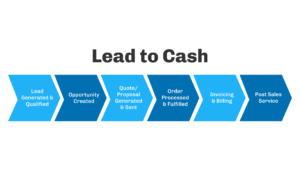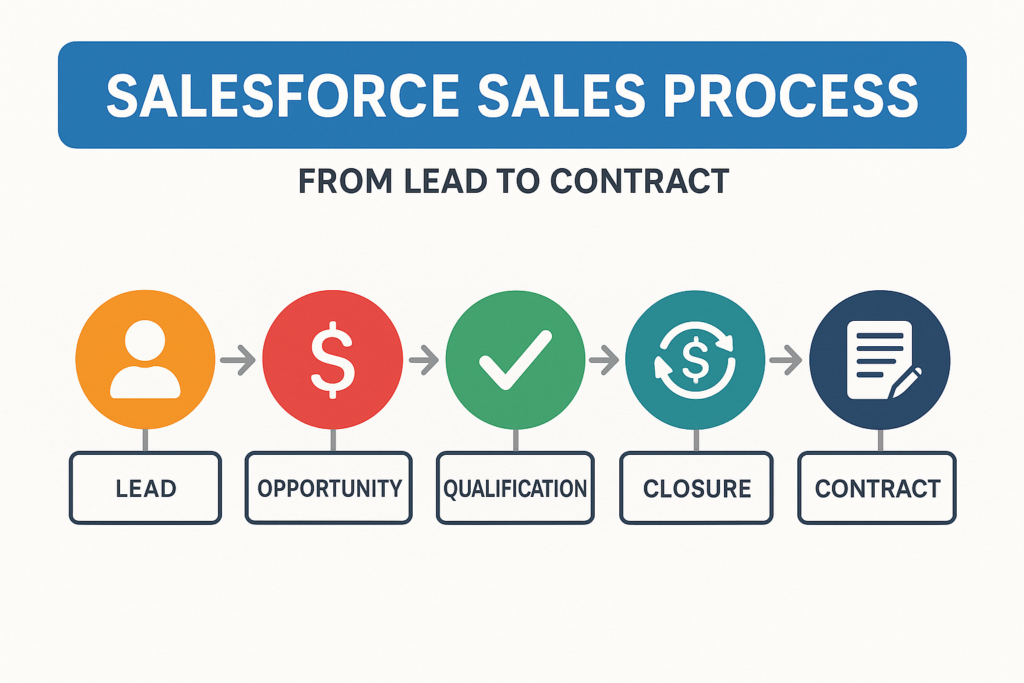It covers how leads are captured, nurtured, converted, and how they progress through opportunities, quotes, orders, and contracts. It also explains B2B vs B2C scenarios.

1. Lead Generation & Management
Leads can be captured from multiple sources such as Web-to-Lead forms, social media campaigns, events, referrals, advertisements, cold calls, or purchased lists. The ‘Lead Source’ field in Salesforce tracks the origin of the lead.
Sources of Leads
Leads can arrive via:
-
Web-to-Lead forms, automatically capturing inquiries from your website
-
Referrals, events, social media, call campaigns, etc.
It’s vital to track Lead Source properly. When converting a lead, Salesforce populates the source fields on Account, Contact, and Opportunity. You can also override Opportunity Lead Source for accurate attribution.
Lead Nurturing
Lead nurturing involves regular follow-up, sending marketing emails, sharing content, and providing demos. The goal is to build trust and move the lead towards qualification.
2. Lead Qualification & Conversion
Once a lead meets qualification criteria, it is converted into Account, Contact, and Opportunity. In B2B scenarios, the Account represents the company and Contact represents a person within the company. In B2C scenarios, Person Accounts are used where the Account and Contact are merged into a single record.
Once qualified, a lead is converted—generating:
-
Account (company)
-
Contact (individual)
-
Opportunity (potential deal)
All these are created in one seamless action during Lead Conversion.
B2B vs. B2C Differences
-
B2C: Typically involves shorter cycles, simpler orders. You may bypass quotes altogether—going straight to account creation, orders, and assets.
-
B2B: Involves complex configurations and approvals. The process typically includes all stages: Lead → Opportunity → Quote → Order → Contract → Assets.
Salesforce’s Lead-to-Cash framework enables end-to-end management—from capturing the initial inquiry to final payment and fulfillment.
3. Opportunity Management
An Opportunity represents a potential revenue-generating deal. Sales stages might include Prospecting, Qualification, Needs Analysis, Proposal, Negotiation, and Closed Won/Lost.
The Opportunity represents the future sale:
-
You can track Opportunity Stages (e.g., Prospecting, Proposal, Negotiation, Closed) in your sales cycle.
-
Metrics like Closed-Won vs. Closed-Lost help with forecasting and process improvement.
4. Quote & Quote Line Items
Once the opportunity is qualified, one or more quotes can be generated. Each quote contains products (Quote Line Items) with pricing details. One quote is set as Primary to sync data with the Opportunity.
Once an Opportunity is active:
-
You generate a Quote with Quote Line Items—listing products, pricing, and terms.
-
In B2B scenarios, multiple quotes may exist per opportunity, with one marked as Primary.
5. Synchronizing Quote ↔ Opportunity Line Items
When a quote is set as Primary, its products and prices sync with the Opportunity Line Items.
Quotes can sync with their parent Opportunity, ensuring consistency:
-
Price, quantities, and product selections mirror between Quote and Opportunity Line Items.
6. Orders & Order Line Items
Once the customer accepts the quote, an Order is created with Order Line Items. The order formalizes the deal and initiates fulfillment.
Once a quote is accepted:
-
You create an Order (with Order Line Items) to formalize the sale.
-
Salesforce supports multiple orders per opportunity as needed.
7. Contract Creation
Contracts are created to formalize the agreement between the customer and the company. Contracts can be generated from Opportunities, Quotes, or Orders.
Contracts formalize agreements:
-
You can create a Contract directly from a Quote, Opportunity, or Order. Salesforce will automatically link the Contract to its parent.
-
With Salesforce CPQ or CLM, contract management becomes even more robust—supporting document templates, versioning, and lifecycle tracking.
Conclusion
The flow diagram visually represents the process:
Lead → Nurturing → Qualification → Convert to Account, Contact, Opportunity → Quote → Sync with Opportunity → Order → Contract → Billing/Support.

